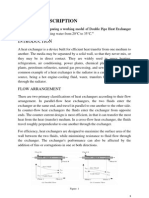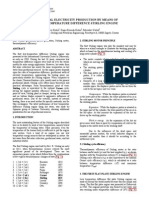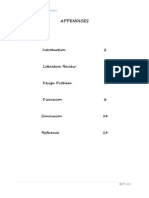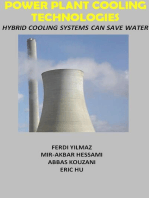Heat Ad Mass Transfer in A Cooling Tower With Special Attention To The Tower Characteristic Ratio
Heat Ad Mass Transfer in A Cooling Tower With Special Attention To The Tower Characteristic Ratio
Uploaded by
AathithyayanSoundararajanCopyright:
Available Formats
Heat Ad Mass Transfer in A Cooling Tower With Special Attention To The Tower Characteristic Ratio
Heat Ad Mass Transfer in A Cooling Tower With Special Attention To The Tower Characteristic Ratio
Uploaded by
AathithyayanSoundararajanOriginal Title
Copyright
Available Formats
Share this document
Did you find this document useful?
Is this content inappropriate?
Copyright:
Available Formats
Heat Ad Mass Transfer in A Cooling Tower With Special Attention To The Tower Characteristic Ratio
Heat Ad Mass Transfer in A Cooling Tower With Special Attention To The Tower Characteristic Ratio
Uploaded by
AathithyayanSoundararajanCopyright:
Available Formats
Project Report 2008 MVK160 Heat and Mass Transport May 08, 2008, Lund, Sweden
Heat ad mass transfer in a cooling tower with special attention to the tower characteristic ratio
Michael Blocher Dept. of Energy Sciences, Faculty of Engineering Lund University, Box 118, 22100 Lund, Sweden
ABSTRACT Explanation and calculation of the tower characteristic ratio for a cooling tower following a procedure from a paper. NOMENCLATURE temperature [K] temperature [C] surface area of water droplets per unit volume of tower (m2 m-3) K mass transfer coefficient (kg h-1 m-2 (kgw/kgda)-1) L water loading (kg h-l m-2) V active tower volume per unit plan area (m3 m-2) c specific heat (kJ kg-1 K-l) cda specific heat of dry air (kJ kg-1 K-l) i enthalpy (kJ kg-1) is specific enthalpy of saturated moist air at the water temperature tw (kJ kg-1) NDCT natural draught cooling tower MDCT mechanical draught cooling tower Subscripts
da a w wi wo 1 2 s
T t a
breakdown of the process in the facility is not acceptable (which it normally isnt). If there are water reservoirs (sea, lakes or rivers) nearby in which the heat can be transferred without environmental concerns, this is the cheapest and easiest way. But unfortunately, this is not often the case and so alternative cooling methods need to be invented and used. One especially well known is the cooling tower, because it is a land mark and is often mistaken for a chimney. PROBLEM STATEMENT The general construction of a cooling tower is governed by different decisions. It is important to construct the tower in a way that it lives up to all the demands the different parties have towards it. I.e. environmental, design, function and price. Cooling towers are not only used in nuclear power plants but also in many other conventional (combustion) power plants to remove excess process heat. Cooling towers can generally be divided into two different kinds: Natural Draught Cooling Towers (NDCT) and Mechanical Draught Cooling Towers (MDCT). Mechanical Draught just indicates that the convection in the tower is not natural but induced by a fan. The relative movement of air and water is the reason for another classification which divides them into cross flow and counter flow towers. And if one considers the mechanism of the cooling in the tower they can be divided into wet, wet-dry and dry cooling towers. Dry cooling towers are basically a radiator like every car or truck uses one. The hot water (that has usually been used to condense the excess steam after a steam turbine) is being pumped through an array of pipes with attached metal plates which then radiate the heat to the air that flows (or is being
dry air moist air water inlet water outlet water air inlet condition air outlet condition saturated
INTRODUCTION Every power plant or larger industrial facility produces excessive heat that cannot be used further (due to the entropy rise). This heat has to be transferred to the environment if a
blown) through the cooling tower. This type has a very big advantage. The water in the cooling circuit is not being evaporated and therefore problems with mineral deposits can be avoided. The big disadvantage is that its cooling capacity is far below that of the other two designs. A Wet cooling tower uses parts of the hot water that needs to be cooled to evaporate and to support the cooling effect of the air by adding extra evaporation cooling to the process (the rest of the water is cooled down more effectively because heat is actively drawn from it when parts of it evaporate). The big advantage of the wet cooling tower is its simplicity and therefore comparatively low cost, but a big disadvantage is just that what makes it so effective. The water that evaporates has to be refilled, and since evaporating water doesnt take its dissolved minerals with it, the water deposits its minerals in the pipes and the tower if the mineral level is not controlled. Wet-dry cooling towers combine the disadvantages of both other designs. They use part of the water to evaporate and cool the water itself plus water that is being pumped through pipes in the so called filling of the cooling tower. This generates on the one hand less steam and therefore lost water, on the other hand is the mineral deposit problem still present, it is more expensive to build and the cooling effectiveness is not as good as that of a purely wet cooling tower. There exist many different options for NDCT, MDCT, cross flow and counter flow designs, but the most common are explained here shortly: Most MDCT designs are cross flowing. That means that the cooling air is ventilated mechanically horizontally through the falling water. This could look like this:
(basically something with a desirably large surface which doesnt block the air flow too much and lets the water run more slowly to the collection basin). A very popular design is a hyperbolic structure because of air flow (like a nozzle) and structural reasons. These buildings are maybe the most filigree concrete structures that are being built with wall thicknesses of sometimes just 18 cm.
For my project calculation Id like to calculate a wet counter flow natural draught cooling tower. LITERATURE SURVEY After having searched ELIN for relevant research material about cooling towers a paper called Knowledge base for the systematic design of wet cooling towers, 1996, A. K. M. Mohiuddin and K. Kant could be found. It is basically a textbook for the calculation of a cooling tower. PROJECT DESCRIPTION The generally accepted concept of cooling tower performance is in terms of the tower characteristic ratio (KaV/L), which is basically a measure of the effectiveness of a cooling tower (cooling capacity divided by the water that runs through it).
Most NDCT designs are counter flowing and have a so called fill or packaging to increase the time the warm water stays in the cold air
To obtain the tower characteristic ratio, one follows the simplifications presented in reference [1] and gets the following equation:
K a V dt t t cw ' w cw wi wo L i ia 4 t wo s
t wi
w x w* s 1
j * where ws is the specific humidity of saturated air and x is the humidity in %.
i
j 1
The basic simplification is that the enthalpy and temperature profile in the tower is being divided into different sections that are then being assumed to have constant values.
* ws 0.62198
pws pt pws
In this equation pt is the total pressure of the air and pws is the partial vapour pressure at saturation. For pws exists an empirical formulation:
ln 105 pws C1T 1 C2 C3T C4T 2 C5T 3 C6 ln T With the constants C1 5800.2206 C2 1.3914993
This is a very good equation to solve, because K, a, V and L are pure tower characteristics and the right hand side are pure demand characteristics with cw, twi, two given and ij being relatively easily calculable.
C3 0.048640239 C4 0.41764768 104 C5 0.14452093 107 C6 6.5459673
For the enthalpy i2 one assumes that the air is saturated with water when it leaves the cooling tower and uses therefore the equations for the enthalpy of saturated water. For temperatures between 10-35C:
i is' ia
ia is the enthalpy of the air flowing through the tower. It can be calculated at the four interesting points using the following formulas:
iA i1 0.1 i2 i1 iB i1 0.4 i2 i1 iC i1 0.6 i2 i1 iD i1 0.9 i2 i1
Where i1 can be obtained via the formula for the enthalpy of unsaturated air.
i2 C7t 1 C8 C9t C10t 2 C11t 3 C12t 4 With the constants C7 53.52515 C8 3.517334 C9 2.809715 C10 0.1669836 101 C11 0.924304110 3 C12 0.9275973 105
i1 cda t1 w 2501 1.805t1
In this equation cda is the specific heat of dry air, t1 is the temperature of the entering air and w is the specific humidity of the air. w can be calculated via:
For temperatures between 35-60C:
t A two 0.1 twi two 35.25C t B two 0.4 twi two 43.5C tC two 0.6 twi two 49C t D t wo 0.9 twi two 57.25C
i2 C13t 1 C14 C15t C16t 2 C17 t 3 C18t 4 With the constants C13 26325.88 C14 3174.125 C15 151.3213 C16 3.762619 C17 0.04617667 C18 0.2495032 10 3
With these two equations, one can also calculate is' for these four integration steps once the water temperature for the different states has been set according to:
Also, the inlet air enthalpy can be calculated. For this one first needs the partial pressure of the already solved water:
pws 47.329086 Pa 4.73 104 bar
* With pt assumed to be 1.013 bar, ws becomes:
* ws 0.62198
pws 2.907 104 pt pws
w x w* 2.035 104 s
With cda = 1.004 kJ kg-1 K-1 the enthalpy for the entering air becomes:
t A two 0.1 t wi two t B two 0.4 t wi two tC two 0.6 t wi two t D t wo 0.9 twi two
One can assume that the air flowing into a cooling tower has about 20C (during the summer it might be warmer, during the winter it might be cooler, but its not really important because this example is purely academic anyway). The air moisture in per cent is probably around 70 (also assumed), and the temperature of the leaving air will not exceed 45C (also assumed). One can further calculate the incoming water as having the temperature of about 60C. The outgoing water has a temperature of roughly in the middle between the incoming and the outgoing air:
i1 cda t1 w 2501 1.805t1 20.582
The enthalpy for the leaving air is:
kJ kg
i2 C13t 1 C14 C15t C16t 2 C17t 3 C18t 4 214.22 kJ kg
Therefore, the enthalpy of the air at the intermediate points can be calculated. kJ kg kJ iB i1 0.4 i2 i1 98.037 kg kJ iC i1 0.6 i2 i1 136.765 kg kJ iD i1 0.9 i2 i1 194.857 kg iA i1 0.1 i2 i1 39.946
Also the enthalpy of the saturated air at the intermediate water temperatures can be calculated with the two enthalpy formulas:
two 0.5 tai tao 32.5C
From there, one can calculate the different water temperatures:
CONCLUSIONS
kJ ' iAs 61.702 kg kJ ' iBs 198.711 kg kJ ' iCs 261.864 kg kJ ' iDs 399.015 kg Now, ij can be calculated: kJ kg kJ ' iB iBs iB 100.674 kg kJ ' iC iCs iC 125.099 kg kJ ' iD iDs iD 204.158 kg
' iA iAs iA 21.756
A way to calculate the tower characteristic ratio of a cooling tower has been found and used. Additionally, a lot of tower concepts and other information about cooling has been obtained, but not been used during the writing of this final text. REFERENCES [1] A. K. M. Mohiuddin and K. Kant, 1996, Knowledge base for the systematic design of wet cooling towers, Paper [2] Si Y. Lee, James S. Bollinger, Alfred J. Garrett and Larry D. Koffman, 2008, CFD modeling analysis of mechanical draft cooling tower, Proc. 2008 ASME Summer Heat Transfer Conference, WSRC-STI-2008-00123, Paper in Conference Proceedings [3] www.wikipedia.org
With this knowledge and cw = 4.184 kJ kg-1 K-1 one can now calculate the tower characteristic ratio: t t K a V cw wi wo L 4
4 j 1
1.979
j
With this knowledge, one can now design the cooling tower according to the different parameters. L = amount of cooling water per hour per square meter a = design of the nozzles to disperse the water (finer spray, more surface) K = mass transfer coefficient (amount of air that comes into contact with water) V = active tower volume per unit plan area (how far down is the water falling?) But all of this would exceed the amount of time and space that has been set aside for this project and therefore can be read in reference [1].
You might also like
- ASTM D7264 - Standard Test Methods For Flexural Properties of Polymer Matrix Composites Materials PDFDocument11 pagesASTM D7264 - Standard Test Methods For Flexural Properties of Polymer Matrix Composites Materials PDFDennis100% (1)
- Cooling Tower Design Part I PDFDocument9 pagesCooling Tower Design Part I PDFVictor AugelloNo ratings yet
- Drilling QuizDocument7 pagesDrilling QuizKhirasindhu Baruah75% (4)
- Synopsis Heat ExchangerDocument9 pagesSynopsis Heat ExchangerJitesh PaulNo ratings yet
- Cooling Tower Water CalculationsDocument11 pagesCooling Tower Water CalculationsShesadri ChakrabartyNo ratings yet
- Cooling Towers - Downloaded SkillsDocument22 pagesCooling Towers - Downloaded SkillsVuthpalachaitanya KrishnaNo ratings yet
- Cooling Tower 2020 SPLM1B2 Notes 13 - 14 AugustDocument23 pagesCooling Tower 2020 SPLM1B2 Notes 13 - 14 AugustThabangNo ratings yet
- Cooling Tower - Design ConsiderationsDocument6 pagesCooling Tower - Design Considerationsofelherrera77No ratings yet
- Cooling Technology Institute "Why Every Air Cooled System Condensor Needs A Cooling Tower" (2003)Document16 pagesCooling Technology Institute "Why Every Air Cooled System Condensor Needs A Cooling Tower" (2003)Amir AbbaszadehNo ratings yet
- Cooling Towers Design and Operation ConsiderationsDocument6 pagesCooling Towers Design and Operation ConsiderationsvanmurthyNo ratings yet
- General Types of Cooling Tower IllustrationsDocument10 pagesGeneral Types of Cooling Tower IllustrationsanisalyaaNo ratings yet
- CFDDocument34 pagesCFDSambhav JainNo ratings yet
- Cooling Towers Design and Operation ConsiderationsDocument10 pagesCooling Towers Design and Operation ConsiderationsLiu YangtzeNo ratings yet
- 44-Article Text-82-1-10-20190318Document8 pages44-Article Text-82-1-10-20190318Indra BRNo ratings yet
- Screenshot 2023-01-11 at 8.11.58 PMDocument15 pagesScreenshot 2023-01-11 at 8.11.58 PMAbdla DoskiNo ratings yet
- Cooling TowersDocument35 pagesCooling TowersSingaravelu MariappanNo ratings yet
- Wet-Dry Cooling CTI PaperDocument15 pagesWet-Dry Cooling CTI Paperssriram168100% (2)
- Composition and Characteristics of Goat Milk: Review 1 9 6 8 - 1 9 7 9Document10 pagesComposition and Characteristics of Goat Milk: Review 1 9 6 8 - 1 9 7 91112200001 Agung Muhammad IkhsanNo ratings yet
- Cooling TowerDocument32 pagesCooling TowerPrasoon ChaturvediNo ratings yet
- Colling Tower: Mechanical Lab / Exp. NO.Document10 pagesColling Tower: Mechanical Lab / Exp. NO.Dalal Salih100% (1)
- The Heating of Liquids in TanksDocument25 pagesThe Heating of Liquids in Tanksaleksandar_djordjic100% (2)
- CFD SimulationDocument39 pagesCFD SimulationSambhav JainNo ratings yet
- In Memoriam Ivo KolinDocument5 pagesIn Memoriam Ivo KolinTimuçin KarabulutlarNo ratings yet
- Project Heat and Mass TransferDocument14 pagesProject Heat and Mass TransferAreen Emilia Faizlukman Jerry100% (1)
- Design of Mechanical Draftcooling Tower and Determination of Thermal EfficiencyDocument7 pagesDesign of Mechanical Draftcooling Tower and Determination of Thermal EfficiencyMoch FaridNo ratings yet
- Chapter 7 Steam CondenserDocument44 pagesChapter 7 Steam Condenserabe9090901No ratings yet
- Heat Pipe in HvacDocument11 pagesHeat Pipe in HvacOmkar ChavanNo ratings yet
- Shopmillingmsme: Steam Jet Refrigeration SystemDocument7 pagesShopmillingmsme: Steam Jet Refrigeration SystembbaytlNo ratings yet
- Shopmillingmsme: Steam Jet Refrigeration SystemDocument7 pagesShopmillingmsme: Steam Jet Refrigeration SystembbaytlNo ratings yet
- Cooling Towers Design and Operation ConsiderationsDocument8 pagesCooling Towers Design and Operation ConsiderationsThieuhuyen Ky100% (2)
- Shopmillingmsme: Steam Jet Refrigeration SystemDocument7 pagesShopmillingmsme: Steam Jet Refrigeration SystembbaytlNo ratings yet
- Presentation 1Document47 pagesPresentation 1Abhishek KumarNo ratings yet
- Cooling Tower1Document66 pagesCooling Tower1Er Bali Pandhare100% (1)
- Condenser and Circulating Water SystemDocument26 pagesCondenser and Circulating Water SystemKhairun Nisa100% (1)
- Steam Jet Refrigeration SystemDocument7 pagesSteam Jet Refrigeration SystembbaytlNo ratings yet
- Shopmillingmsme: Steam Jet Refrigeration SystemDocument7 pagesShopmillingmsme: Steam Jet Refrigeration SystembbaytlNo ratings yet
- Steam Jet Refrigeration SystemDocument7 pagesSteam Jet Refrigeration SystembbaytlNo ratings yet
- Steam Jet Refrigeration SystemDocument7 pagesSteam Jet Refrigeration SystembbaytlNo ratings yet
- Cooling Tower Formulae-ImpDocument4 pagesCooling Tower Formulae-ImptpplantNo ratings yet
- Shell and Tube Heat Exchanger DesignDocument22 pagesShell and Tube Heat Exchanger Designsuperbugima100% (1)
- Cooling TowersDocument11 pagesCooling TowersSlim Kat Nkosi0% (2)
- Steam Jet Refrigeration SystemDocument7 pagesSteam Jet Refrigeration SystembbaytlNo ratings yet
- Mirjana S. LAKOVI), Slobodan V. LAKOVI), and Miloš J. BANJACDocument11 pagesMirjana S. LAKOVI), Slobodan V. LAKOVI), and Miloš J. BANJACAnonymous YcAZv5qF67No ratings yet
- 3.7 Cooling TowersDocument6 pages3.7 Cooling TowersSaurabh VijNo ratings yet
- Cooling TowerDocument14 pagesCooling TowerAbdulla DoskiNo ratings yet
- Heat Exchanger Mid-Term ReportDocument18 pagesHeat Exchanger Mid-Term ReportkoanakistNo ratings yet
- Cooling Water System DesignDocument66 pagesCooling Water System Designraghuragoo100% (2)
- SRL Diagnostics: Types of Cooling Tower - Cooling Tower Basic CalculationsDocument13 pagesSRL Diagnostics: Types of Cooling Tower - Cooling Tower Basic CalculationssumitNo ratings yet
- Cooling TowerDocument28 pagesCooling TowerIbrahim DanladiNo ratings yet
- Cooling TowerDocument28 pagesCooling TowermaneeshNo ratings yet
- Minimizing Energy Costs With Free Cooling: Technical Resources Technical ResourcesDocument12 pagesMinimizing Energy Costs With Free Cooling: Technical Resources Technical ResourcesAnonymous 7z6OzoNo ratings yet
- Condenser Performance Analysis and Its ImprovementDocument23 pagesCondenser Performance Analysis and Its Improvementanup_nair100% (2)
- IES-CONV-Mechanical Engineering-2006Document10 pagesIES-CONV-Mechanical Engineering-2006aditya_kumar_meNo ratings yet
- 05 Component SizingDocument67 pages05 Component Sizingpal_stephenNo ratings yet
- A25 LabsheetDocument5 pagesA25 LabsheetKFC yipNo ratings yet
- Mechanics of the Household: A Course of Study Devoted to Domestic Machinery and Household Mechanical AppliancesFrom EverandMechanics of the Household: A Course of Study Devoted to Domestic Machinery and Household Mechanical AppliancesNo ratings yet
- Encyclopaedia Britannica, 11th Edition, Volume 8, Slice 3 "Destructors" to "Diameter"From EverandEncyclopaedia Britannica, 11th Edition, Volume 8, Slice 3 "Destructors" to "Diameter"No ratings yet
- Thermodynamic analysis of geothermal heat pumps for civil air-conditioningFrom EverandThermodynamic analysis of geothermal heat pumps for civil air-conditioningRating: 5 out of 5 stars5/5 (2)
- Theoretical Stress Distribution Elastic Multi-Layered System in AnDocument7 pagesTheoretical Stress Distribution Elastic Multi-Layered System in AnURBANHIJAUNo ratings yet
- Comparison of Severity of Exposure in ASTM E 119 A-1Document10 pagesComparison of Severity of Exposure in ASTM E 119 A-1Huy NguyenNo ratings yet
- Basic Concepts and Example Problems On Hydraulic FracturingDocument4 pagesBasic Concepts and Example Problems On Hydraulic FracturingJatin RamboNo ratings yet
- Answer - To - Subjective HydraulicsDocument3 pagesAnswer - To - Subjective Hydraulicsmellon3duwenNo ratings yet
- Ch.1. Description of Motion: Multimedia Course On Continuum MechanicsDocument115 pagesCh.1. Description of Motion: Multimedia Course On Continuum MechanicsMiguel GallegoNo ratings yet
- ASTM Structural Sections Imperial 2006Document36 pagesASTM Structural Sections Imperial 2006Oscar CruzNo ratings yet
- What Are Some of The Best Interview Questions Asked For A Mechanical Engineering Student - Quora PDFDocument17 pagesWhat Are Some of The Best Interview Questions Asked For A Mechanical Engineering Student - Quora PDFPavansatya AdabalaNo ratings yet
- Introduction To Aerodynamics - Part 5: Professor Dr. Mazharul Islam, P.Eng. (Alberta, Canada)Document37 pagesIntroduction To Aerodynamics - Part 5: Professor Dr. Mazharul Islam, P.Eng. (Alberta, Canada)mazhar1970No ratings yet
- HVAC Systems III: Air-and-Water and All-Water SystemsDocument8 pagesHVAC Systems III: Air-and-Water and All-Water SystemsEmad Mohamed Sofy AminNo ratings yet
- Refresher Module 20 - (S6) - Basic-Structural-EngineeringDocument1 pageRefresher Module 20 - (S6) - Basic-Structural-EngineeringMadelyn Oronos100% (1)
- 00320773Document304 pages00320773Anirudh SabooNo ratings yet
- Access Engineering: Combined Footing Design Based On ACI 318-99Document7 pagesAccess Engineering: Combined Footing Design Based On ACI 318-99আসিফ মাহমুদNo ratings yet
- Section Lib Classical Lamination Theory: by Charles W. BertDocument6 pagesSection Lib Classical Lamination Theory: by Charles W. BertPothuri sairama krishnam rajuNo ratings yet
- Glass TransitionDocument10 pagesGlass TransitionVladimir VladimirovNo ratings yet
- SimCentral TDM User GuideDocument83 pagesSimCentral TDM User Guidejrtn100% (1)
- Design Guidelines - KRT Submersible Motor Pumps-DataDocument110 pagesDesign Guidelines - KRT Submersible Motor Pumps-DataChristopher Garcia100% (1)
- Lab Manual - To Study Refrigeration Cycle, Determine of Coefficient of Performance of Cycle & Determine of Tonnage Capacity of Refrigeration UnitDocument4 pagesLab Manual - To Study Refrigeration Cycle, Determine of Coefficient of Performance of Cycle & Determine of Tonnage Capacity of Refrigeration UnitManikanta BoyinaNo ratings yet
- (A) Same As That of A' (B) One-Fourth As That of A' (C) Twice As That of A' (D) Four Times As That of A'Document6 pages(A) Same As That of A' (B) One-Fourth As That of A' (C) Twice As That of A' (D) Four Times As That of A'Aduchelab AdamsonuniversityNo ratings yet
- SteelDocument17 pagesSteelkimchhoungNo ratings yet
- Class-XI-Physics-SP-marking scheme-SET 1Document5 pagesClass-XI-Physics-SP-marking scheme-SET 1Dhivya.k Dhivya.kNo ratings yet
- Steady Vortex Flow in Tangential IntakeDocument8 pagesSteady Vortex Flow in Tangential IntakeEdgar ChuquipiondoNo ratings yet
- Propulsion Question Bank 1Document14 pagesPropulsion Question Bank 1aeroherozNo ratings yet
- 3MANOEXMPLEDocument5 pages3MANOEXMPLEBlue SkyNo ratings yet
- EG0222032301 Solar Carport Mounting System-Area A ASCE 7-10) - 10x21Document20 pagesEG0222032301 Solar Carport Mounting System-Area A ASCE 7-10) - 10x21SalauddinAnsariNo ratings yet
- Lecture 4 Characterization of GeotextilesDocument71 pagesLecture 4 Characterization of GeotextilesChin Thau WuiNo ratings yet
- Mat Chapter 18Document29 pagesMat Chapter 18hemant_durgawaleNo ratings yet
- Effect of Creep, Shrinkage and Cracking On Time Dependent Behaviour of RC StructuresDocument7 pagesEffect of Creep, Shrinkage and Cracking On Time Dependent Behaviour of RC StructuresLavinia DamianNo ratings yet
- Design of Members For FlexureDocument16 pagesDesign of Members For FlexureJade CarilloNo ratings yet

























































































